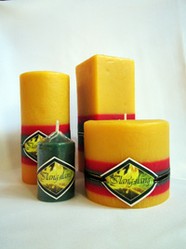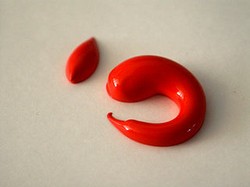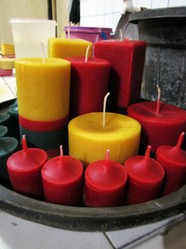The Philippines is rich with, not only birds and butterflies, but fragrant plants as well. From aromatic flowers cultivated in wide orchards, to shrubs and trees grown on front yards, and wild orchids that greet the daybreak with bursts of perfume from freshly opened blossoms, exotic great scents come to you in the breeze in the Philippines. Natural essential oils from some of these aromatic plants are used as aromatherapy oils, perfume fragrances, and scents for candles and soaps. What are the best scented candles, therapeutic oils and great perfume fragrances you could make or find out of these fragrant oils? Here is a list of the best essential oils from the tropical islands of the Philippines.

The 12 Best Scents and Essential Oils from the Philippines
Natural essential oils are used as aroma oils, perfume fragrances, and scents for candles and soaps. Here is a list of the best scents from the Philippines.
Ylang-ylang
First on our list of best essential oils is the ylang-ylang, or Cananga odorata, an extremely fragrant tree native to the Philippines, and the leading light of Philippine aromatherapy. The ylang-ylang, or ilang-ilang, blossoms with star-like yellow flowers that exude a strong sweet aroma. The rich scent of ylang-ylang, not only captivates, but is believed to heal. Ylang-ylang’s deep medicinal scent is known to lift and calm the spirit, restoring a person from loneliness, depression and other mood-related illnesses, like motion-sickness and hypertension. An aphrodisiac, ylang-ylang also awakens a person's mood for love.
Ylang-ylang essential oil is one of the best scents of candles and aroma oils. Scented candles and aromatherapy oils that whiff off ylang-ylang fragrance are widely available in stores and online, so you could buy ylang-ylang fragrance to fill up your home even if you live outside the Philippines. In your bedroom, by the window, in your private retreat, in your bathroom, place the ylang-ylang scented candles or essential oil diffuser, and let the clean medicinal aroma of ylang-ylang nourish you, reviving and preserving your emotional wellness.
Jasmine Sampaguita
Closely following the ylang-ylang in our list of best essential oils comes from the Philippine national flower: the sampaguita, or Jasminum sambac, better known in English by the erroneous name Arabian jasmine. This white flower growing on a semi-climbing shrub was originally native, not to Arabia, but in India. The Arabian jasmine arrived in the Philippines in the 7th century, and has embraced the islands so pervasively since the flower has become a natural, inseparable part of Philippine landscape. The sweet beatific fragrance of its flowers endears the Arabian jasmine to everyone, finding its way in leis around Filipinos' neck, in corsages and crowns.
The fragrance of Arabian jasmine essential oil is creamy and sweet with a mild hint of lemony floral tang, making the jasmine oil one of the best essential oils, not only as scents for candles and aroma oils, but as perfume fragrances. The scent of Arabian jasmine is comely and magnetizing, enthralling in its sweetness. Sampaguita aroma products are best enjoyed in weddings, in anniversaries, and as gifts to friends and acquaintances. Of course, for your home scents, you won’t go wrong with leaving the pure fragrant freshness of the Arabian jasmine to waft around your airy living room.
Vanilla
Another of the best essential oils known around the world comes from vanilla. Imported from Mexico during the Spanish colonization, vanilla is an orchid that took root in the Philippines and even gave birth to several more kinds, including Tahitian vanilla — which is indeed a native of the Philippines and not of Tahiti. The taxonomy of vanilla orchids is yet unclear though. What is certain is, vanilla is prized, not only for its floral aroma, but for the flavor it adds to food and drink, lining it up among the famous variations of ice cream. Not to be left out are vanilla scented candles and aromatherapy oils, which enchant a household with their irresistible creamy scent, so thickly sweet and chocolatey the aroma is by itself almost edible.
Thus, beside enjoying top spot among ice cream flavors, vanilla essential oil makes one of the best smelling candles and aroma oils. Alongside Arabian jasmine, vanilla makes a great home scent. Hence, in your kitchen, on the dining table, in every part of the house where you lie down and laze around, wallow in the aroma that reminds you of chocolate, of ice cream, of everything sweet. Indulge in the delightful scent of vanilla.
Lemongrass
Lesser known of essential oils, yet makes one great candle scent and aroma oil, is the lemongrass, or Cymbopogon citrates, native to the islands of Southeast Asia. The lemongrass is particularly prominent, not just among aromatherapy oils and scents for candles, but above all in Philippine cuisine. A good pot of Philippine stew almost always holds a wad of lemongrass somewhere, as do Philippine roasted chickens and whole pigs, otherwise known as lechon. That's because the flat green blades of lemongrass spices up a dish with its inviting lemony aroma, as well as a citrus flavor that excites the tongue.
As pleasurable as it is to humans, however, lemongrass essential oil is a natural insect repellant like its cousin citronella, and drives away mosquitoes with its fragrant scent, making it a great home scent. Hence, with the sweet yet insect-repellant fragrance of lemongrass scented candles and aromatherapy essential oils, you can protect your children and yourself from mosquito bites, while bathing in the fragrant aroma of lemongrass at the same time.
Patchouli
One of the best essential oils, not just among aromatherapy oils and candle scents but most especially among perfume fragrances, is the patchouli, or Pogostemon cablin, a bushy shrub native to the tropical regions of Asia. A heavy strong fragrance comes from the leaves of the patchouli plant, and the natural essential oil extracted from them is considered one of the most important essential oils in the perfume industry. Because patchouli scent blends well with other perfume fragrances, patchouli essential oil is commonly mixed with other essential oils to make various perfumes.
Mindanao Cinnamon
Cinnamon is undeniably of the best essential oils in the world, and is especially famous in the culinary arts. There are species of cinnamon endemic to the Philippines, and the one cultivated for its essential oil is the Mindanao Cinnamon, or Cinnamomum mindanaense, which as the name suggests is native to the island of Mindanao. Like other species of cinnamon, Mindanao cinnamon is prized for its bark, which is used to spice up Filipino cooking, not excluding breads and cakes. Cinnamon essential oils carry a sweet fragrance that is wonderfully earthy, spicy and musky. Mindanao cinnamon aroma makes a great scent for candles, aroma oils, as well as perfume fragrances.
Lime
Native to Southeast Asia, the key lime, or Citrus aurantiifolia, is a small tree that bears small edible round fruits called limes. Limes are squeezed to make juice, which, apart from being drunk as beverage, is also stirred into Filipino cooking to add sour tartness to the recipe. Essential oil is extracted from limes too, and used for aromatherapy oils, perfume fragrances and candle scents. Like orange scent and other essential oils from fruits, lime essential oil is best incorporated into festive scented candles, or candles made for joyous occasions and festive celebrations.
Indian Sandalwood
The Indian sandalwood, or Santalum album, is a small tree distributed from India to much of Southeast Asia and Australia. Sandalwood is valued for its distinctively fragrant wood. The woody scent of sandalwood has a sweet minty edge to it, and this bright freshness of sandalwood essential oil makes it popular, not just among essential oils used as candle scents, aromatherapy oils and soap and perfume fragrances, but also as flavoring for candies taken to freshen breath.
Vetiver
Originally native to South Asia and now widely cultivated in Asia’s tropical regions, vetiver, or Chrysopogon zizanioides, is a grass fragrant like lemongrass. Distilled from the roots, vetiver essential oil has a fresh green scent. Like patchouli, vetiver fragrance is widely used as additive to mix with other essential oils in making perfume fragrances, more so in western countries. Vetiver scent is particularly added in men’s perfumes, what with vetiver essential oil’s strong clean scent.
Cedarwood
Cedarwood, specifically deodar cedar or Cedrus deodara, is a large beautiful coniferous tree originally coming from the mountains of the Himalayas. While cultivated mostly for timbers, cedarwood essential oil is extracted from the wood shavings and sawdust of deodar cedar. Cedarwood fragrance is woodsy, strong and sweet, comparable — many say superior — to pine. With its calming effect to the nerves, cedarwood figures prominently among essential oils used as aroma oils and candle scents, as well as soap and perfume fragrances. Due to deodar cedar’s insect-repellant and antifungal properties, cedarwood essential oil is also used as ingredient in room sprays and disinfectants.
Rose
Rose is a fragrant flower distributed across the world, not excluding the Philippines. The fragrance of rose is mild and fresh, with a sweet floral note to it that is mostly interpreted as romantic. Like the actual flowers, rose fragrance is a Valentine’s Day favorite. Rose oil, produced from the rose flower’s petals, is among the popular essential oils used as scents for candles, aroma oils and perfume fragrances.
Coconut
The Philippines is the biggest producer of coconut oil. While it may not be the sweetest fragrance to many, the milky scent of coconut in aroma candles can vividly remind people of the Philippines’ coconut-dotted tropical islands. The coconut palm, or Cocos nucifera, is found throughout the tropics, but has especially graced the Philippines, where it has become an unshakable part of Philippine cuisine, landscape and economy.
A Recap of the 12 Best Essential Oils from the Philippines
The closest I can find on Amazon, anyway.
AdThe Other Scents
Not all sweet-smelling plants in the Philippines are turned into essential oils. These fragrant plants have huge potential for aromatherapy or perfumery, but are not cultivated for the purpose. The beautiful blossom of magnolia champaka, for instance, gives off a delightful fragrance, but is not widely manufactured into perfume fragrances. Other fragrant plants are extensively used, but not as essential oils for perfume fragrances, aromatherapy oils or candle scents, but as food or flavors in Philippine cuisine. These aromatic plants include pili nut, nutmeg and pandan, or the fragrant screw-pine.
About the Author
Deomar Pandan is a visual artist, online writer and jeweler. He recently launched kamayojewelry.com, and is the artist behind the jewelry items shown in the website.
You might also like
The 11 Different Visual Art MediaThere is an art medium for every artist, the one that he’d love and make mast...
16 Candle-making Supplies and Equipments to Make CandlesCandle-making is a fun craft to do. Do you want to make candles? Get to know ...





































 What Camera to Buy: Compact, Digital SLR or just Phone Camera?on 03/06/2013
What Camera to Buy: Compact, Digital SLR or just Phone Camera?on 03/06/2013
 12 Art Supplies and Materials for Painting with Acrylic Painton 02/15/2013
12 Art Supplies and Materials for Painting with Acrylic Painton 02/15/2013
 16 Candle-making Supplies and Equipments to Make Candleson 02/03/2013
16 Candle-making Supplies and Equipments to Make Candleson 02/03/2013
 The 11 Different Visual Art Mediaon 01/22/2013
The 11 Different Visual Art Mediaon 01/22/2013



Which scent do you think you like?
Wow, I really want to try osme of these scents. The pics make them look amazing.